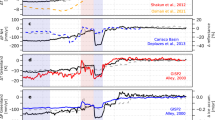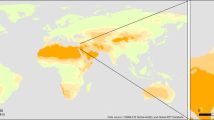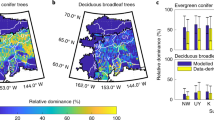Abstract
GLOBAL climatic change may alter species' ranges as well as restructuring ecosystems1–3. Models simulating forest growth predict that the area covered by different forest types may be affected2, which may in turn further affect climate3. In the mixed forests of southern Ontario, pollen analyses have demonstrated that after AD 1400, Fagus (beech), the formerly dominant warmth-loving species, was replaced first by oak (Quercus) and subsequently by pine (Pinus strobus). Although these changes had been attributed to aboriginal forest clearance4–6, they have also been seen in areas unaffected by aboriginal farming, and are now thought to reflect Little Ice Age cooling7. Although modelling suggests that some forests may take several centuries to reach equilibrium after a climatic change8,9, a real forest showing this behaviour has not previously been identified. Here we model the Little Ice Age by a 2 °C decrease in mean annual temperature from AD 1200 to 1850, and show that the changes predicted by a forest simulator derived from FORET10match those seen in southern Ontario. These forests thus appear to have remained in disequilibrium with the prevailing climate for more than 650 years.
This is a preview of subscription content, access via your institution
Access options
Subscribe to this journal
Receive 51 print issues and online access
$199.00 per year
only $3.90 per issue
Buy this article
- Purchase on Springer Link
- Instant access to full article PDF
Prices may be subject to local taxes which are calculated during checkout
Similar content being viewed by others
References
Melillo, J. M., Callaghan, T. V., Woodward, F. I., Salati, E. & Sinha, S. K. in Climate Change: The IPCC Scientific Assessment (eds Houghton, J. T., Jenkins, G. J. & Ephraums, J. J.) 283–310 (Cambridge University Press, New York, 1990).
Pastor, J. & Post, W. M. Nature 334, 55–58 (1988).
Bonan, G. B., Pollard, D. & Thompson, S. L. Nature 359, 716–718 (1992).
McAndrews, J. H. in Vegetation History (eds Huntley, B. & Webb, T. III) 673–697 (Kluwer, New York, 1988).
McAndrews, J. H. & Boyko-Diakonow, M. in Quaternary Geology of Canada and Greenland (ed. Fulton, R. J.) 528–530 (Geological Survey of Canada, Ottawa, 1989).
Burden, E. T., McAndrews, J. H. & Norris, G. Can. J. Earth Sci. 23, 43–54 (1986).
Campbell, I. D. & McAndrews, J. H. Can. J. Bot. 69, 1719–1730 (1991).
Davis, M. B. & Botkin, D. B. Quat. Res. 23, 327–340 (1985).
Solomon, A. M. & Bartlein, P. J. Can. J. For. Res. 22, 1727–1738 (1992).
Shugart, H. H. A Theory of Forest Dynamics (Springer, New York, 1984).
Davis, M. B. Am. J. Sci. 261, 897–912 (1963).
Delcourt, P. A., Delcourt, H. R. & Webb, T. III Atlas of Mapped Distributions of Dominance and Modern Pollen Percentages for Important Tree Taxa of Eastern North America (Am. Ass. Stratigraphic Palynologists, Dallas, 1984).
Bradshaw, R. H. W. & Webb, T. III Ecology 66, 721–737 (1985).
Campbell, I. D. thesis, Univ. Toronto, 1992.
Godman, R. M. & Lancaster, K. in Silvics of North America vol. 1: Conifers (eds Burns, R. M. & Honkala, B. H.) 604–612 (United States Department of Agriculture Forest Service Handbook 654, Washington DC, 1990).
Pennington, W. Vegetatio 67, 105–118 (1986).
Davis, M. B. Ecology 50, 312–332 (1969).
Bryson, R. A. Quat. Res. 15, 143–159 (1981).
Solomon, A. M. Oecologia 68, 567–579 (1986).
Davis, M. B. in Community Ecology (eds Diamond, J. & Case, T. J.) 269–284 (Harper and Row, New York, 1986).
Delcourt, H. R., Delcourt, P. A. & Webb, T. III Quat. Sci. Rev. 1, 153–175 (1983).
Johnson, E. A. Fire and Vegetation Dynamics: Studies from the North American Boreal Forest (Cambridge Univ. Press. New York, 1992).
Bernabo, J. C. Quat. Res. 15, 143–159 (1981).
Author information
Authors and Affiliations
Rights and permissions
About this article
Cite this article
Campbell, I., McAndrews, J. Forest disequilibrium caused by rapid Little Ice Age cooling. Nature 366, 336–338 (1993). https://doi.org/10.1038/366336a0
Received:
Accepted:
Issue Date:
DOI: https://doi.org/10.1038/366336a0
This article is cited by
-
Differences in forest composition following two periods of settlement by pre-Columbian Native Americans
Vegetation History and Archaeobotany (2022)
-
Effects of recent climate and environmental changes on the ecology of a boreal forest lake in Manitoba, Canada
Journal of Paleolimnology (2021)
-
Alpine soil carbon is vulnerable to rapid microbial decomposition under climate cooling
The ISME Journal (2017)
-
Intensive land use in the Swedish mountains between AD 800 and 1200 led to deforestation and ecosystem transformation with long-lasting effects
Ambio (2015)
-
Compositional vegetation changes and increased red spruce abundance during the Little Ice Age in a sugar maple forest of north-eastern North America
Plant Ecology (2012)
Comments
By submitting a comment you agree to abide by our Terms and Community Guidelines. If you find something abusive or that does not comply with our terms or guidelines please flag it as inappropriate.



